Stepping into the Scrap Cycle

An Elementary School Visit
This post was written by JMM School Program Coordinator Paige Woodhouse. To read more posts from Paige, click here!
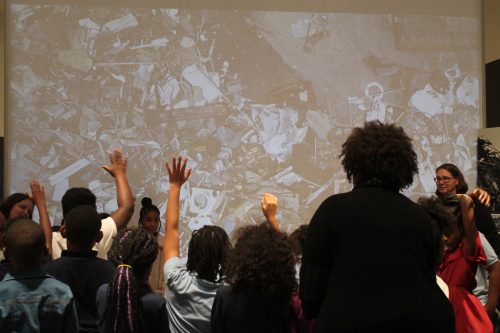
When students from George Washington Elementary School were asked what they thought they might see in our Scrap Yard: Innovators of Recycling exhibit, they responded with examples of recyclable items, like plastic bottles and metal. They guessed that they might see a recycling plant or maybe people at work. One student shared that they might see old and worn out things that can’t be used anymore but could be made into something new.
While they listed ideas of what they might encounter, the class didn’t yet know that they would not just be seeing objects and people connected to the scrap industry; they would be actively exploring the scrap cycle.
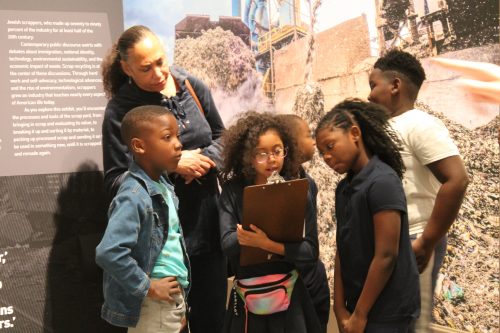
Starting a Scrap Business
The scrap industry grew through the hard work of early 20th century immigrants. Collecting and selling scrap was an opportunity available to newcomers from Eastern and Southern Europe. Students were introduced to families that had their roots in the scrap industry. The class learned about how every member of the family had a role in the business. These family businesses would often be passed from the parents to their children.
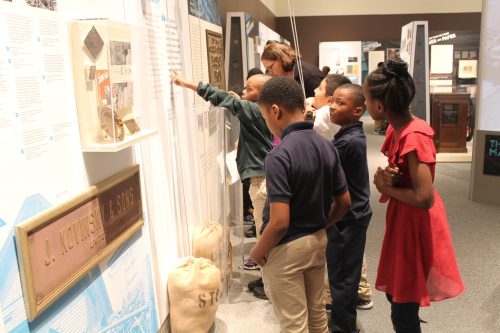
Collecting Scrap
In the 19th century, the only tool a scrap peddler needed was a sack to carry their haul. The weight of their sacks – filled with metal, glass, rag, or paper – mounted up fast. Scrap peddlers carried their sacks all day as they worked to make a living. Students participated in our “Pull up your Sacks” activity to see if they were as strong as a scrap peddler. As the scrap industry evolved, so did the method of transporting scrap.
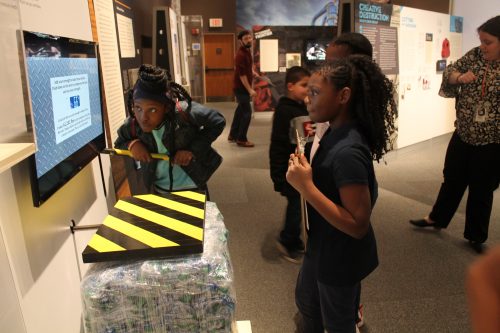
Taking Scrap Apart
Workers in the scrap industry had to be creative when figuring out how to take apart scrap for its parts. The value of a discarded object, like the motorcycle, is not in its wholeness but in all of its different parts. Standing around the motorcycle at the entrance of the exhibit, students identified steel, tires, and plastic as parts that make up the motorcycle.

Sorting Scrap
Dwarfed by an enormous picture of a grappling claw next to a mountainous pile of scrap, the class looked closely at this image – the workers, the different materials, and the scale of the site – and considered how scrap yards sort their materials. Impressed by the giant machinery, one student suggested that massive magnets might do the job.
Non-ferrous scrap, such as aluminum, copper, lead, or zinc, is metal that does not contain any iron. Ferrous scrap is metal and metal alloys that contain iron such as steel and cast iron. The iron content in ferrous materials makes it magnetic. This is an important characteristic for sorting scrap as magnets are used to sort ferrous from non-ferrous scrap. Students simulated this sorting on a much smaller scale than that seen in a modern scrap yard. They used handheld magnets to separate their mystery metals.
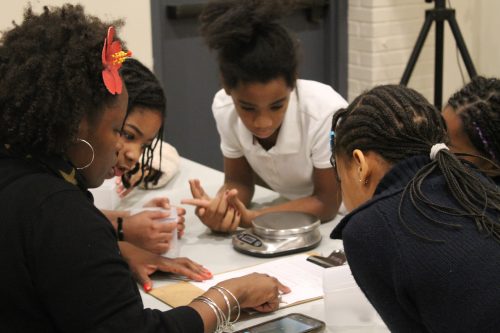
Weighing their Scrap
A scale might be the most important tool in any scrap yard. Scales are used to weigh materials and it is the material’s weight that determines its price. Once their materials had been sorted, the 4th-graders used small scales, like those used by scrap peddlers, to weigh their ferrous and non-ferrous metal.
Selling their Scrap
Students then sold their scrap materials to a company that would make something new from them, in this case, a car manufacturing company. Using the weight of their ferrous and non-ferrous materials, students calculated the price of their scrap to determine their group’s profit. With their scrap sold to other companies, students shared products that could be made from recycled materials, including cars, plastic plates, water bottles, toys, and paper.
4th-graders from George Washington Elementary School did encounter examples of items that could be recycled in the Scrap Yard: Innovators of Recycling exhibit. They also saw historic photographs of what it was like to work in the scrap industry as well as drone footage of a modern scrap yard. They saw examples of people working in the scrap industry in a variety of roles. But students didn’t just see the history and technology behind the scrap industry, they stepped into the shoes of scrap workers and experienced it for themselves.
JMM designed this program for upper elementary students, you can read about the educational program tailored towards middle school students here.
